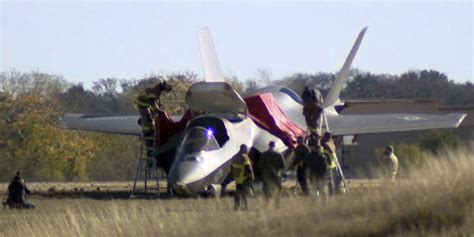
F-35 in Texas Transmits Data 5,000 Miles to Denmark in Real-Time Test
FORT WORTH, Texas – A U.S. Air Force F-35A Lightning II fighter jet, during a recent exercise in Texas, successfully transmitted sensor data over 5,000 miles to Denmark in real-time, demonstrating the aircraft’s advanced communication and data-sharing capabilities. This long-range data transfer, highlighting the F-35’s role as a critical node in a broader network of allied defense systems, underscores the aircraft’s ability to enhance situational awareness and interoperability among partner nations. The successful test marks a significant advancement in integrating international defense networks and leveraging the F-35’s sophisticated sensor suite for enhanced global security.
The data transmission, conducted during a routine training exercise, utilized the F-35’s advanced communication systems to relay information collected by its onboard sensors directly to a ground station in Denmark. This capability allows for the rapid dissemination of critical intelligence, surveillance, and reconnaissance (ISR) data across vast distances, potentially enabling faster and more informed decision-making in complex operational environments. The test not only demonstrated the technical feasibility of long-range data transfer but also highlighted the potential for enhanced collaboration and information sharing between the U.S. and its allies.
According to Lockheed Martin, the manufacturer of the F-35, the successful data transfer underscores the aircraft’s designed capabilities. “The F-35’s ability to share data across vast distances, in near real-time, is a game-changer,” stated a company representative. “It provides commanders with unprecedented situational awareness and allows for a more coordinated response to emerging threats.” This statement emphasizes the strategic importance of the F-35 as an information hub within allied defense networks.
Details of the Data Transfer and Technology Involved
The specific details of the data transmitted during the exercise remain classified, but it is understood that the information included a range of sensor data collected by the F-35’s onboard systems. These sensors encompass a variety of technologies, including radar, electronic warfare systems, and electro-optical/infrared (EO/IR) sensors, which provide a comprehensive view of the battlespace. The F-35’s advanced sensor fusion capabilities allow it to integrate data from multiple sources into a single, coherent picture, which can then be shared with other platforms and command centers.
The technology enabling this long-range data transfer is primarily attributed to the F-35’s Multifunctional Advanced Data Link (MADL), a proprietary communication system designed for secure and high-bandwidth data exchange. Unlike traditional communication systems, MADL is specifically engineered to transmit large volumes of data in a stealthy and secure manner, minimizing the risk of interception or jamming by adversaries. The system is critical for maintaining the F-35’s stealth capabilities while simultaneously enabling it to function as a key node in a network-centric warfare environment.
The successful transfer also hinged on the robust communication infrastructure on both the U.S. and Danish ends. The ground station in Denmark was equipped with the necessary hardware and software to receive and process the data transmitted by the F-35. This required seamless integration of communication protocols and data formats to ensure compatibility between the U.S. and Danish systems. The exercise served as a valuable opportunity to validate the interoperability of these systems and identify areas for potential improvement.
Implications for International Defense Cooperation
The successful data transfer has significant implications for international defense cooperation, particularly among nations that operate the F-35. Denmark, a participant in the F-35 program, is expected to receive its first aircraft in the coming years. The ability to seamlessly integrate Danish F-35s into a broader network of allied defense systems will greatly enhance the country’s security and contribute to a more coordinated response to regional and global threats.
The F-35 is designed to be interoperable with a wide range of allied platforms and systems, allowing for seamless data sharing and collaboration. This interoperability is crucial for conducting joint operations and maintaining a common operating picture in complex environments. By leveraging the F-35’s advanced communication and sensor capabilities, allied nations can enhance their collective situational awareness, improve decision-making, and increase the effectiveness of their military forces.
Furthermore, the ability to transfer data over long distances has implications for remote sensing and surveillance. The F-35 can be deployed to areas of interest and collect valuable intelligence data, which can then be transmitted back to command centers for analysis. This capability is particularly useful in regions where traditional surveillance assets may be limited or unavailable.
The F-35’s Role in Network-Centric Warfare
The successful data transfer reinforces the F-35’s role as a critical component of network-centric warfare. Network-centric warfare is a military doctrine that emphasizes the importance of information sharing and collaboration in modern warfare. By connecting various platforms and systems through a common network, military forces can achieve a higher level of situational awareness, improve coordination, and increase the effectiveness of their operations.
The F-35 is designed to be a key node in this network, providing a continuous stream of real-time data to other platforms and command centers. Its advanced sensors, communication systems, and data fusion capabilities allow it to collect, process, and disseminate information more effectively than traditional aircraft. This information can then be used to support a wide range of military operations, including air-to-air combat, air-to-ground attack, intelligence gathering, and electronic warfare.
The F-35’s ability to share data with other platforms is particularly important in contested environments, where adversaries may attempt to disrupt communication networks. The aircraft’s stealth capabilities and secure communication systems make it difficult for adversaries to intercept or jam its signals, ensuring that critical information can be transmitted reliably even in the face of enemy action.
Challenges and Future Development
Despite the successful data transfer, there are still challenges to overcome in fully realizing the F-35’s potential as a network-centric warfare platform. One challenge is ensuring the interoperability of the F-35 with a wide range of legacy systems and platforms. Many allied nations still operate older aircraft and systems that may not be fully compatible with the F-35’s advanced communication protocols. Bridging these gaps will require significant investment in software upgrades, hardware modifications, and training programs.
Another challenge is managing the vast amount of data generated by the F-35’s sensors. The aircraft’s advanced sensors can collect an unprecedented amount of information about the battlespace, but processing and analyzing this data can be a daunting task. Developing new algorithms and software tools to automate the analysis process and filter out irrelevant information will be crucial for maximizing the value of the F-35’s sensor data.
Looking ahead, the F-35 program is expected to continue to evolve and improve as new technologies are developed and integrated into the aircraft. Future upgrades may include enhanced sensor capabilities, improved communication systems, and advanced artificial intelligence algorithms. These upgrades will further enhance the F-35’s ability to collect, process, and disseminate information, making it an even more valuable asset for allied military forces. Lockheed Martin continues to invest heavily in the F-35 program, focusing on enhancing its capabilities and reducing its operational costs.
Controversies and Criticisms
Despite its advanced capabilities, the F-35 program has been subject to significant controversy and criticism. The program has been plagued by cost overruns, delays, and technical challenges. Critics have questioned the aircraft’s affordability, reliability, and suitability for certain missions. Some have argued that the F-35 is too expensive and complex to be a viable replacement for older aircraft.
However, supporters of the F-35 program argue that the aircraft’s advanced capabilities justify its high cost. They point to the F-35’s stealth capabilities, sensor fusion, and network-centric warfare capabilities as key advantages over older aircraft. They also argue that the F-35 will become more affordable as production volumes increase and the program matures.
The debate over the F-35 program is likely to continue for years to come. However, the successful data transfer demonstrated in Texas provides further evidence of the aircraft’s potential to enhance international defense cooperation and improve the effectiveness of allied military forces. As the F-35 continues to be deployed and integrated into allied defense networks, its role in shaping the future of warfare will become increasingly apparent.
Denmark’s Role and Future Integration
Denmark’s planned integration of the F-35 into its air force represents a significant modernization effort. The country is expected to replace its aging F-16 fleet with the F-35, enhancing its air defense capabilities and contributing to NATO’s collective security efforts. The successful data transfer to Denmark highlights the potential benefits of integrating the F-35 into the Danish defense network.
The Danish government has emphasized the importance of interoperability with allied forces in its defense planning. The F-35’s ability to seamlessly share data with other platforms and systems is a key factor in its selection as Denmark’s next-generation fighter aircraft. The country is investing in the necessary infrastructure and training programs to ensure that its F-35s can be fully integrated into the allied defense network.
The integration of the F-35 into the Danish air force is expected to have a positive impact on the country’s economy. The program will create new jobs in the defense industry and stimulate technological innovation. Denmark is also expected to benefit from the transfer of technology and expertise associated with the F-35 program.
Conclusion
The successful data transfer from an F-35 in Texas to Denmark underscores the transformative potential of this advanced fighter jet in modern warfare. The F-35’s ability to collect, process, and disseminate information in real-time, over vast distances, represents a significant leap forward in network-centric warfare. While challenges and controversies remain, the F-35 is poised to play a crucial role in shaping the future of international defense cooperation and enhancing the security of allied nations. The ongoing development and integration of the F-35 program will continue to be closely watched as it evolves and adapts to the ever-changing landscape of modern warfare. The demonstration of its advanced capabilities serves as a testament to the significant investments made in this program and its potential to provide a decisive advantage to allied forces in the years to come. The real-time data transfer proves the F-35’s potential as a crucial element in global security and coordinated defense strategies.









